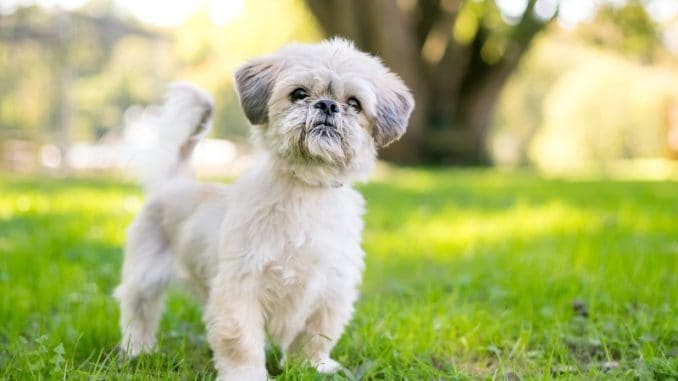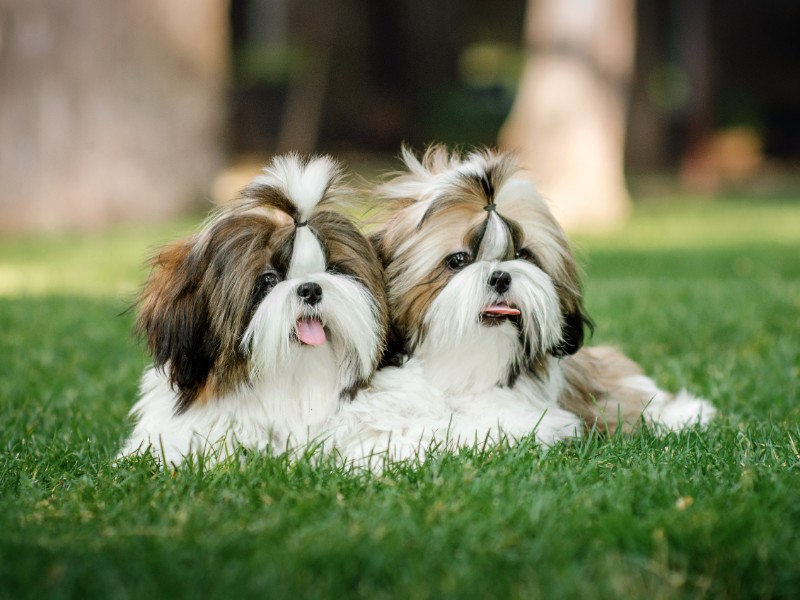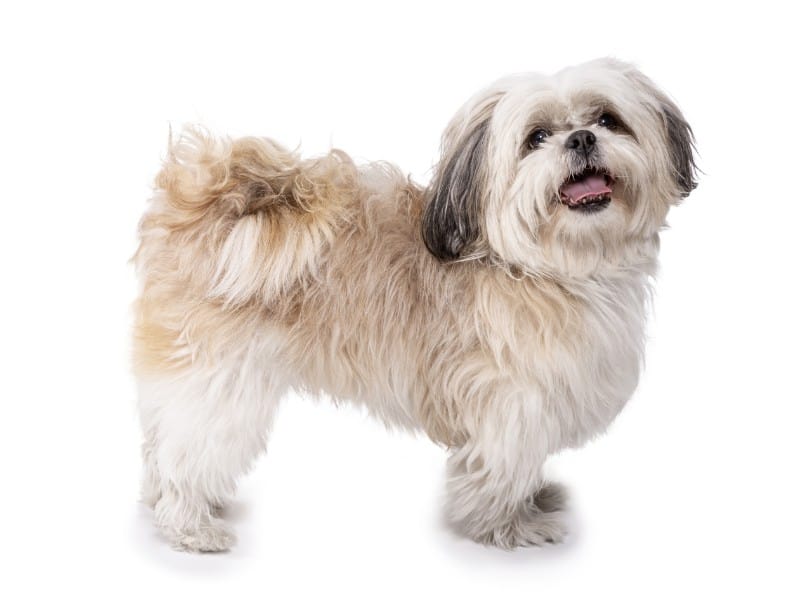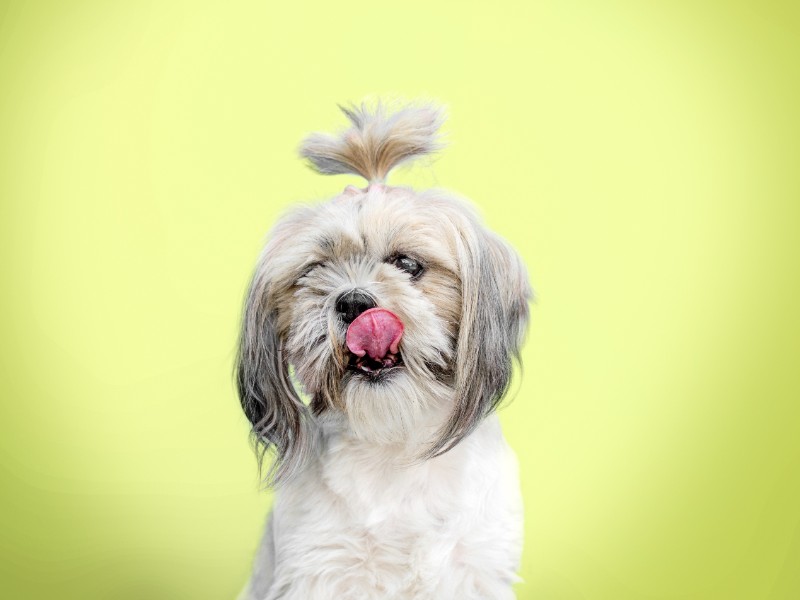
The shih tzu is a small, affectionate dog known for their feisty personalities. Shih tzus have a long life span and often live up to 16 years.
Shih tzus have beautiful fur and long double coats, which means that these dogs need plenty of grooming and maintenance. Well-trained shih-tzus are suitable for any household, although this breed can be stubborn and needs an experienced owner.
TABLE OF CONTENTS
Shih Tzu Quick Summary
Before you take home a dog you should do plenty of research about the breed. Shih tzus have specialized needs, even more so than some other pedigree breeds, so you should know what you’re getting into beforehand.
| Breed Type | Toy dog, lap dog |
| Suitable For | Individuals, families, experienced dog owners, and owners with plenty of time to groom and play with the do |
| Size | 7.9–11 inches |
| Weight | 8.8–16.5 pounds |
| Grooming Needs | High, with daily brushing, regular baths, and professional grooming services |
| Lifespan | 10–16 years, with an average of 12 years |
| Color Variations | Gold, liver, black, white, brown, grey, tricolor or bicolor in any combination, solid color, or multicolored patterns |
| Temperament | Affectionate, playful, and clever, with a stubborn streak |
| Daily Exercise | Low, less than 10–15 minutes of exercise a day |
| Daily Food Consumption | 1–1.5 cups of dry kibble a day, with treats |
| Known Health Conditions | Brachycephalic syndrome, dry eye, distichiasis, intervertebral disc disease |
Shih Tzu Appearance

From Adobe Stock
Shih tzus are known for their long, flowing double coats. These dogs have floppy ears and a long, furry tail that curls over onto their backs.
A shih tzu’s fur grows long and straight and easily reaches the floor. This leaves a shih tzu susceptible to tangles and matting. These dogs also have the well-known “squished face” found in other breeds, like lhasa apsos, bulldogs, and pugs which can cause breathing difficulties in some dogs.
Height and Weight
Shih tzus are small dogs. They usually grow up to 11 inches and weigh up to 16.5 pounds. There isn’t much variation between male and female shih tzus.
Like many other types of lapdogs, shih tzus are often overfed and under-exercised. While shih tzus don’t need a lot of exercise — at least compared to other dogs — they do need to be fed a balanced diet. Some owners skip the exercise, thinking that their small dog doesn’t need to move much. This leads to an overweight dog and all the associated health issues.
Shih tzu puppies are tiny, weighing between 1.25 pounds and 4 pounds by the time they are eight weeks old.
Coat
A shih tzu’s coat grows continually and needs daily brushing if it’s kept long. Many owners choose to cut their shih tzu’s coat short to make it easier to maintain. However, a shih tzu will still need daily brushing, regardless of coat length. Shih tzus also require regular dog grooming, like nail clipping and tooth cleaning.
You should pay for professional grooming for your shih tzu. Shih tzus need regular cuts, monthly nail trimmings, and regular baths. Shih tzus have a “fringe” of hair that curls forward over their eyes, making it difficult for the dogs to see and irritating the shih tzu’s eyes. Some dog owners tie their shih tzu’s bangs up in a topknot to get the hair out of their eyes.
Allergy Information
Shih tzus are hypoallergenic dogs, even with their long coats. They don’t shed, and any loose hairs are usually trapped in the dog’s coat.
However, it’s still possible to have an allergic reaction to a shih tzu. The dog’s dander and saliva cause reactions in some people, and allergies can be triggered during the dog’s grooming time.
Shih Tzu Origins
Shih tzus are an old breed of dog originating from Asia, and were highly prized by Chinese royals. Originally a cross between a pekinese and a lhasa apso, the shih tzu breed can be traced back to the 14th century.
These dogs were so highly valued by their owners that they weren’t traded or sold, and were only given as valuable, meaningful gifts. Shih tzus were introduced into Europe in the 1930s.
Shih tzus were bred to be lap dogs and companion dogs. The Kennel Club officially recognized these dogs on 7th May 1940, and by the American Kennel Club in 1969.
Shih Tzu Personality and Temperament
Shih tzus have a mind of their own. They are lap dogs and enjoy affection, attention, and care. Most shih tzus will climb onto your knee and sit there as long as you let them.
Proper training and socialization is essential for this breed. Shih tzus can quickly become spoiled, disobedient, and nippy if they aren’t properly trained. These dogs have a stubborn streak, and they are intelligent.
A well-trained shih tzu is affectionate, friendly, and great with small children and other pets.
Taking Care of a Shih Tzu
A shih tzu requires a lot of grooming, training, and attention. Although they don’t need a lot of exercise, shih tzus still need mental stimulation.
Food Needs
Like most dogs, shih tzus are greedy and will try and convince you that you haven’t fed them enough. This can be dangerous, and many lapdog owners fall into the trap of overfeeding and under exercising their pets.
A shih tzu needs 1–1.5 cups of high-quality dry food each day. If a shih tzu gets more exercise than recommended, you can feed the dog more food than the average shih tzu should receive. However, If the dog is underweight, it should be fed less food until it is healthy.
A shih tzu puppy should eat one ounce of food per pound of body weight, whereas an adult should eat half an ounce per pound of body weight. Use this rule to figure out how much you should be feeding your shih tzu as it ages.
How to Groom a Shih Tzu

From Adobe Stock
Grooming a shih tzu is a time-consuming business. Professional dog groomers are the best option, but groomers can be expensive. You can groom your dog at home if you have the right tools, enough time, and plenty of patience. Grooming can even be a good bonding experience for you and your dog.
Start by thoroughly brushing your dog. Shih tzus need regular daily brushing, or, at minimum, brushing every other day. If you don’t brush your shih tzu, their fur will get matted and it will need to be shaved.
Use a cotton ball to remove eye gunk and debris from around the dog’s eyes, and use ear drops or ear wipes to clean the inside of the shih tzu’s floppy ears.
Brush your shih tzu before you give the dog a bath. When bathing your shih tzu, use dog shampoo and conditioner to keep the dog’s long fur sleek and smooth. After the bath, brush and detangle the shih tzu’s fur again.
Once brushing and bathing is done, you should clip or shave your shih tzu. Having somebody to hold your dog still is helpful. If you’re grooming a shih tzu for the first time, be sure to do plenty of research first. This will prevent your dog from ending up with a wonky haircut or nicks and cuts.
Exercise Needs
Shih tzus have low exercise needs. These dogs need 10–15 minutes of exercise a day, but this can vary depending on your dog’s age, health, and energy levels. Shih tzus have little legs and are bred to be lap dogs, not working dogs. Most shih tzus prefer short walks to long hikes.
However, a small amount of exercise is important. A small dog still needs daily physical exercise.
In muddy areas or during rain and bad weather, a shih tzu will get cold, and the dog’s long coat — which might drag on the floor — will get wet. Buy a dog coat for your shih tzu to wear during bad weather and avoid taking muddy walking routes.
Mental Needs
Shih tzus are intelligent dogs and need plenty of mental stimulation. Puzzle games are popular for shih tzus because they allow you to play and bond with your dog without over-tiring it.
Shih tzus are lap dogs and instinctively want to be with their owners and with people. Leaving a shih tzu alone for a long time will lead to your pet becoming bored. Boredom increases the likelihood of destructive behaviors.
You should set aside time to play with your shih tzu and keep playtime separate from exercise, feeding, and grooming time.
Common Health Concerns
One of the most common health concerns in a shih tzu is the dog’s flat face. Shih tzus are a brachycephalic breed, meaning that they have short muzzles with wide, short skull shapes. This shape was caused by inbreeding as a result of breeders trying to give their dogs a certain look.
The short muzzle and flat face of brachycephalic breeds — like shih tzus, pugs, and french bulldogs — mean that the dogs struggle to breathe. This leads to panting, snorting, heavy breathing, or more serious respiratory complications. The shih tzu’s eyes will pop out further than they should, and the eyes are more prone to excessive eye-watering, eye infections, and injury.
Some modern shih tzus have longer muzzles and lengthier skulls because some breeders are beginning to understand the dangers associated with short muzzles.
Training a Shih Tzu Dog
Shih tzus are intelligent dogs and can learn quickly. However, these dogs can also be stubborn and are notoriously difficult to house-train. Here are some puppy training tips to help you.
The best age to start puppy training your shih tzu is 12 weeks, when the puppy is still open-minded and willing to learn. By this age, a shih tzu is intelligent and confident enough to progress with basic training, and young enough to be receptable. Spend time bonding with your puppy first, and be as patient as you can. Training a shih tzu is a time-consuming process.
Start house training your shih tzu puppy as soon as possible. Shih tzus have small bladders, and these dogs need to use the toilet frequently. Start by taking your puppy out regularly, especially after the dog has eaten or drank or after a period of play and excitement. Wait for your shih tzu puppy to do its business, then praise it afterward.
Socialize your shih tzu by taking the puppy to crowded places to see other animals and areas with visual stimulation. It’s more difficult to socialize an older shih tzu than an open-minded younger shih tzu.
Crate training is a good way to teach a shih tzu to be alone. Shih tzus are prone to separation anxiety, and creating a safe, comfortable crate for your dog to relax in will help your pet to feel more at home.
Shih tzus are stubborn, and these dogs don’t respond well to punishment, unkindness, or shouting. Stay calm and patient when training your shih tzu, and use positive reinforcement to reward the behavior you want to see.
Shih Tzu Price

From Adobe Stock
Shih tzus are expensive dogs. Along with the initial cost of buying a shih tzu puppy, there are ongoing grooming costs, healthcare, and the costs of toys. Buying a cheap shih tzu or adopting can increase the risk of getting a dog with expensive health problems or genetic defects.
How Much is a Shih Tzu?
A shih tzu costs $750–$3000 if you buy from a breeder. The price difference is affected by whether or not the dog is Kennel Club registered, the appearance of the dog, and whether or not the dog is the runt of the litter. Adopting a shih tzu costs $150–$300.
Shih tzu puppies cost more than adults, but this can vary depending on the individual dog’s circumstances. Do your research before buying or adopting a dog that is prone to health conditions like a shih tzu.
How Much Does it Cost to Raise a Shih Tzu?
The average monthly cost of raising a shih tzu is $240–$420 per month. This cost includes food, grooming, pet insurance, vet visits, entertainment, and toys.
The initial setup cost, including food and water bowls, pet carrier, toys, brush, bed, ID tag, and collar – will cost $143–$410.
Should You Get a Shih Tzu?
Shih tzus are beautiful, affectionate dogs, and they’re great with children, other pets, and big families. However, not every household is suitable for a shih tzu.
Who Should Get a Shih Tzu?
Shih tzus are a good choice for moderately active households with plenty of time and patience to care for a dog. Shih tzus get on well with other pets and children if the dog is properly trained. People who love their pets and enjoy spending time cuddling their dogs are a perfect match for a shih tzu.
The shih tzu’s affectionate nature makes this dog a suitable pet for most households. If you can properly care for your dog’s needs and spend time with your pet, a shih tzu is a good choice.
Who Shouldn’t Get a Shih Tzu?
Shih tzus aren’t suitable for first-time dog owners. These dogs can be stubborn and are notoriously difficult to housetrain. Shih tzus aren’t compatible with highly active owners and other active pets. This is because they only have small legs and tire quickly and are lap dogs at heart.
Because the grooming and maintenance costs for a shih tzu can quickly mount up, this breed isn’t an appropriate choice for households on a tight budget. Households with little time for their pet are also unsuitable because shih tzus don’t like to be left alone for too long.
Shih Tzu FAQs
- Where do shih tzus come from?
- Why is my shih tzu shaking?
- What does shih tzu mean?
- How much does a shih tzu weigh?
- How long does a shih tzu live?
- When is a shih tzu full grown?
- Do shih tzus like to swim?
- How often do you have to bathe a shih tzu?
- How much should a shih tzu eat?
- What are the cons of owning a shih tzu?
- Are shih tzus smelly dogs?
- Are shih tzus good for first-time dog owners?
- Do shih tzus like to cuddle?
- Can shih tzus be left alone?
- How much does a shih tzu cost?
- Do shih tzus bark a lot?
- Are shih tzus high maintenance?

Be the first to comment